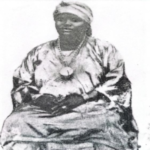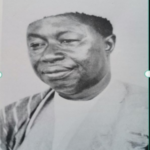JOHN KONNY
John Konny (c. 1660-1732), or Conny, of Pokoso or Prince’s Town, 27 mi (43 km) west-south-west of Takoradi, in the state of Ahanta, lying between the Ankobra and Pra rivers in the coastal region of what is now Ghana, is reputed to have been the most prominent merchant prince on the Gold Coast in the late 17th and early 18th centuries. A successful trader and an able diplomat, he took possession of the former Prussian fort of Gross Friederichsburg (Great Fredericksburg), which stood on a hill near his town, from 1711-24, and was able to defy the power of both the English and the Dutch for nearly 15 years.
His early life is obscure. He is known to have served the Brandenburg African Company for a while, and to have learned English from the traders. The Elector of Brandenburg had built Gross Friederichsburg in 1682; in 1701 Brandenburg became the Kingdom of Prussia; and in 1708 the Prussians officially abandoned the fort.) John Konny’s name features in European records from 1711, when he is said to have deposed the Prussian Governor of Gross Friederichsburg, de Lange, who appears still to have been in occupation. Thereafter Konny made Pokoso the most attractive trading center for African and European merchants, also succeeding in controlling the trade to Asante and other places in the interior. His policy of free trade led to interopers (i.e. European traders from other nations) entering his territory. To combat this, the Dutch and British formed an alliance and attacked him, but Konny, with the aid of Wassa, a state about 40 mi (64 km) to the north, and Asante, defeated them at Akwida, near Cape Three Points, a few miles to the east of Prince’s Town, and extended his power over Ahanta.
Between 1711 and 1724, he extended his influence into Asante. In 1716 a war with Asante and Wassa was prevented by some Asante traders who saw that it would endanger trade. He thereafter became very friendly with Opoku Ware (q.v.), ruler of Asante from 1720-50, sending him builders, apparently to construct a European-style palace for him.
After the death of Frederick I of Prussia (formerly the Elector of Brandenburg) in 1713, the Prussians lost interest in their Gold Coast possessions, which the Dutch then proposed to purchase from them. Konny opposed the purchase, and sent an emissary to Prussia to explain matters to them. The Dutch, however, nevertheless negotiated the purchase secretly in 1717. But Konny refused to surrender Gross Friederichsburg to them.
In about 1720 the Dutch sent a “bomb vessel and two or three frigates” against him, bombarded his town, and landed 40 men to attack him. Konny, at the head of his men, however, counterattacked and killed the Dutchmen, later “paving the entrance to his palace with their skulls.” In 1722, when he agreed to the transfer of the fort to the Dutch on certain terms, they tried to ask for more, and when he refused, they took Gross Friederichsburg by storm in 1724.
Konny has been called “the last Prussian Negro Prince” because of this defence of the Brandenburg possessions. After his defeat, he fled to Fanteland and later to Asante. He was a considerate person, who was lavish in the entertainment of guests, and punctilious in observing ceremonial events. But for the European intervention in his affairs, he might have spread his influence more widely in southern Ghana.
K. YEBOAH DAAKU


